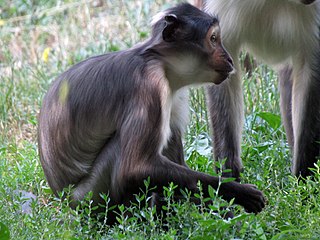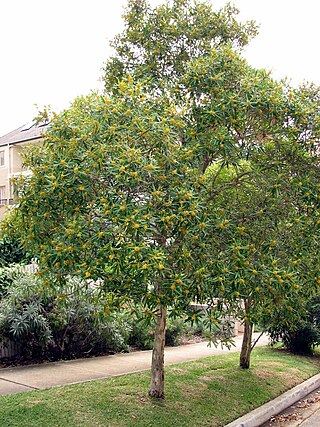
Tristania is a monotypic genus of flowering plants native to New South Wales, Australia, closely related to Thaleropia. The genus had a number of species, but some have been reclassified as Lophostemon and Tristaniopsis. The sole species currently in the genus is Tristania neriifolia. It is known commonly as the water gum.

The white-eyelid mangabeys are African Old World monkeys belonging to the genus Cercocebus. They are characterized by their bare upper eyelids, which are lighter than their facial skin colouring, and the uniformly coloured hairs of the fur. The other two genera of mangabeys, Lophocebus and Rungwecebus, were once thought to be very closely related to Cercocebus, so much so that all the species were placed in one genus, but Lophocebus and Rungwecebus species are now understood to be more closely related to the baboons in genus Papio, while the Cercocebus species are more closely related to the mandrill.

Tristaniopsis is a group of shrub and tree in the myrtle family Myrtaceae described as a genus in 1863. They have a wide distribution in Southeast Asia, New Guinea, New Caledonia and Australia.

Tristaniopsis laurina, the water gum or kanooka, is a tree species native to Australia. It usually grows near the eastern coastline and along the banks of streams, where the trunks and branches tend to be shaped in the direction of the current and give an indication of the flood height.
Clusia minutiflora is a species of flowering plant in the family Clusiaceae. It is found only in Ecuador. Its natural habitat is subtropical or tropical moist montane forest.
Garcinia minutiflora is a species of flowering plant in the family Clusiaceae. It is a tree endemic to Peninsular Malaysia.
Tristaniopsis decorticata is a species of plant in the family Myrtaceae. It is endemic to the Philippines. It is threatened by habitat loss.
Tristaniopsis littoralis is a species of plant in the family Myrtaceae. It is endemic to the Philippines. It is threatened by habitat loss.
Tristaniopsis pontianensis is a species of plant in the family Myrtaceae. It is found in Malaysia and Singapore. It is threatened by habitat loss.
Tristaniopsis razakiana is a species of plant in the family Myrtaceae, formerly known as Tristania razakiana.
Tristaniopsis lucida is a species of plant in the family Myrtaceae. It is endemic to New Caledonia.
Tristaniopsis macphersonii is a species of plant in the family Myrtaceae. It is endemic to New Caledonia.
Tristaniopsis polyandra is a species of plant in the family Myrtaceae. It is endemic to New Caledonia.
Tristaniopsis reticulata is a species of plant in the family Myrtaceae. It is endemic to New Caledonia.
Tristaniopsis vieillardii is a species of plant in the family Myrtaceae. It is endemic to New Caledonia.
Tristaniopsis yateensis is a species of plant in the family Myrtaceae. It is endemic to New Caledonia. It is threatened by habitat loss.

Mount Hamiguitan is a mountain located in the province of Davao Oriental, Philippines. It has a height of 1,620 metres (5,315 ft). The mountain and its vicinity has one of the most diverse wildlife populations in the country. Among the wildlife found in the area are Philippine eagles and several species of Nepenthes. Some of the latter, such as the Nepenthes peltata and Nepenthes micramphora, are endemic to the area. The mountain has a protected forest area of approximately 2,000 hectares. This woodland is noted for its unique pygmy forest of century-old trees in ultramafic soil, with many endangered, endemic and rare species of flora and fauna.

The World's 25 Most Endangered Primates is a list of highly endangered primate species selected and published by the International Union for Conservation of Nature (IUCN) Species Survival Commission (SSC) Primate Specialist Group (PSG), the International Primatological Society (IPS), Global Wildlife Conservation (GWC), and Bristol Zoological Society (BZS). The IUCN/SSC PSG worked with Conservation International (CI) to start the list in 2000, but in 2002, during the 19th Congress of the International Primatological Society, primatologists reviewed and debated the list, resulting in the 2002–2004 revision and the endorsement of the IPS. The publication was a joint project between the three conservation organizations until the 2012–2014 list when BZS was added as a publisher. The 2018–2020 list was the first time Conservation International was not among the publishers, replaced instead by GWC. The list has been revised every two years following the biannual Congress of the IPS. Starting with the 2004–2006 report, the title changed to "Primates in Peril: The World's 25 Most Endangered Primates". That same year, the list began to provide information about each species, including their conservation status and the threats they face in the wild. The species text is written in collaboration with experts from the field, with 60 people contributing to the 2006–2008 report and 85 people contributing to the 2008–2010 report. The 2004–2006 and 2006–2008 reports were published in the IUCN/SSC PSG journal Primate Conservation,, since then they have been published as independent publications.

Prunus minutiflora, called the Texas almond, is a shrub native to Texas and northern Mexico.






